They say timing is everything. Certainly, timing was my main consideration when visiting Armenia. Truthfully, the three countries that make up the Caucasus region in far eastern Europe were on my radar for one reason. I’d read several stories by travel writers who were totally smitten by the Georgian capital of Tbilisi, but otherwise I knew absolutely nothing about the region. I went to Georgia, Azerbaijan, and Armenia simply because they were the only three countries in Europe I hadn’t yet visited.
I soon learned that the logistics of visiting the Caucasus would require more planning than normal. My preference was to begin my travels in Azerbaijan, moving west to Armenia, and finally to Georgia, where I could catch an onward flight to Budapest. But due to the ongoing conflict between Azerbaijan and Armenia over the unrecognized republic of Nagorno-Karabakh, it is not possible to cross the border between those two countries. I considered skipping Armenia completely, but my desire to visit every country in Europe won out. I flew into Azerbaijan, took the train to Georgia, and then backtracked to Armenia on another train. Thank goodness I did. Visiting Armenia was the unexpected highlight of my Caucasus trip.

Just steps from my hotel in the capital city of Yerevan I discovered the oval-shaped Republic Square. The stately curved neoclassical buildings surrounding its central roundabout included the National History Museum, the Post Office, and the Marriott Hotel. Pink colored volcanic tuff used in their construction, as well as many other buildings of note in the city, has earned Yerevan the nickname “The Pink City.” Yerevan is the only major city in the world built out of this stone.
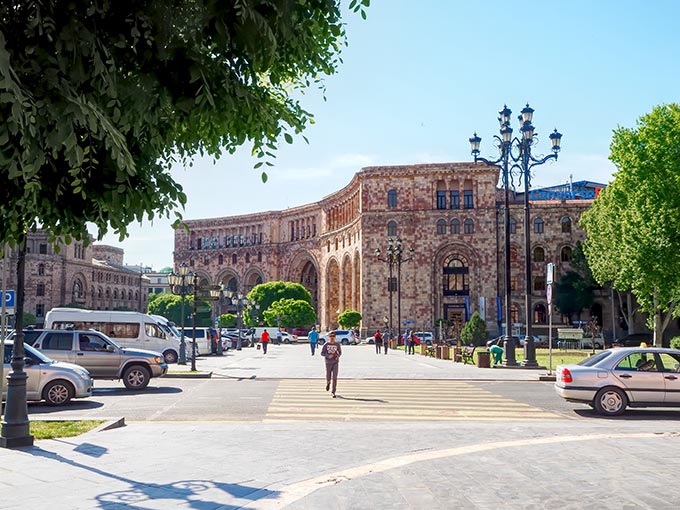
The color of the buildings changes throughout the day, depending upon the angle of the sun. They radiate most brilliantly pink at sunrise and sunset. But during the middle of the day the stone turns golden bronze. My route that first morning took me down Northern Avenue, a pedestrianized shopping street bracketed by mid-rise apartments buildings, with cafes and stores at the street-level. It was a picture-perfect example of the city’s ever-changing palette. At midday, the buildings on one side of Northern Avenue glowed gold; on the other they were a warm salmon pink. The shops dead-ended at the city’s stately Opera and Ballet House. Though it was also constructed from the rare pink tuff, on the shady side, barely a hint of pink was visible.

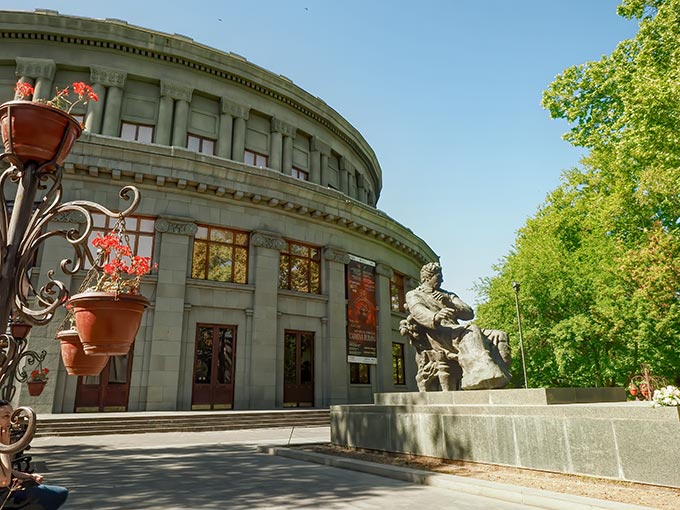
From the Opera House I continued to Cafesjian Sculpture Garden, located in a broad greenspace in the center of Tamanyan Street. The meticulously manicured garden features monumental sculptures, ranging from the Rubinesque (and slightly scandalous) bronze “Woman Smoking a Cigarette” by Colombian sculptor Fernando Botero Angulo, to a granite hulk depicting Alexander Tamanyan. Not only did the Russian born Tamanyan conceive the idea for the sculpture garden, he designed the Opera and Ballet House, Republic Square, and created the first general plan for the city of Yerevan. It seemed fitting that his brooding, hunched sculpture stands at the entrance to Cafesjian Sculpture Garden, on the boulevard named in his honor.
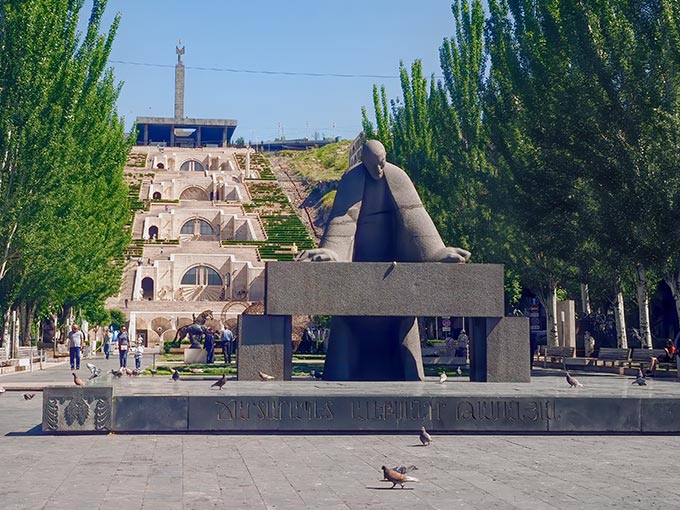
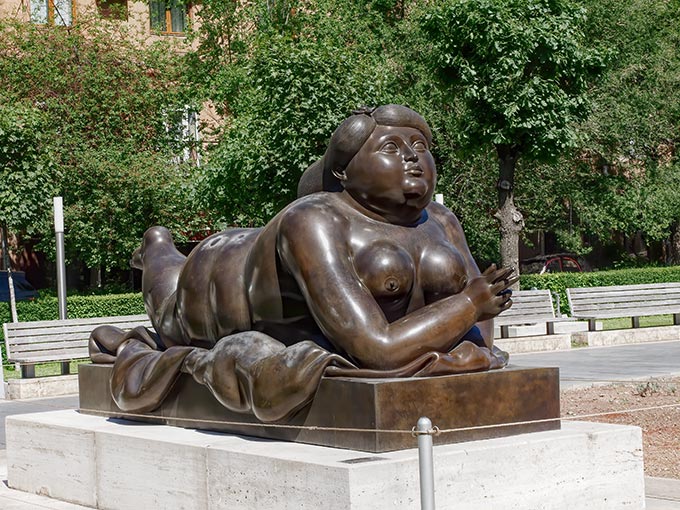
At the end of the park I began climbing the 572 steps of the “The Cascade”, a giant limestone stairway leading to the top of one of the city’s highest hills. The stairway reminded me of the Potempkin Stairs in Odessa, Ukraine, until I turned around. Beyond the lovely sculpture park and pink-tinted architecture rose the snow-capped volcanoes of Mount Ararat and Little Mount Ararat. They seemed to float above the skyline, like some mythical kingdom that can only be reached on a magic carpet. I chuckled softly, thinking, “No Dorothy, you’re not in Ukraine anymore.”
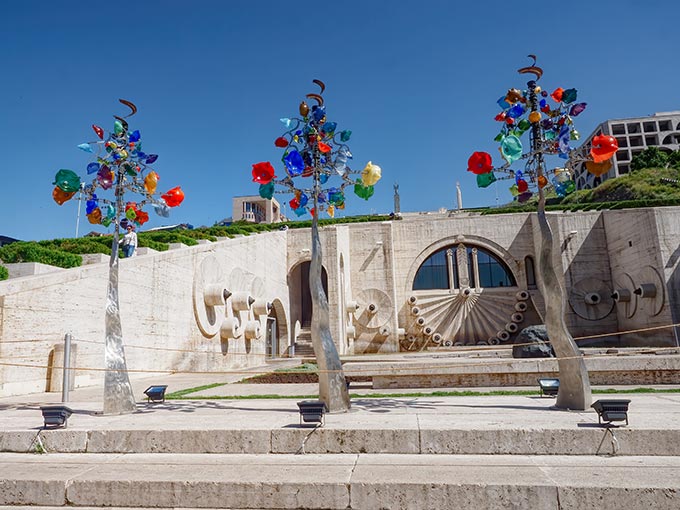
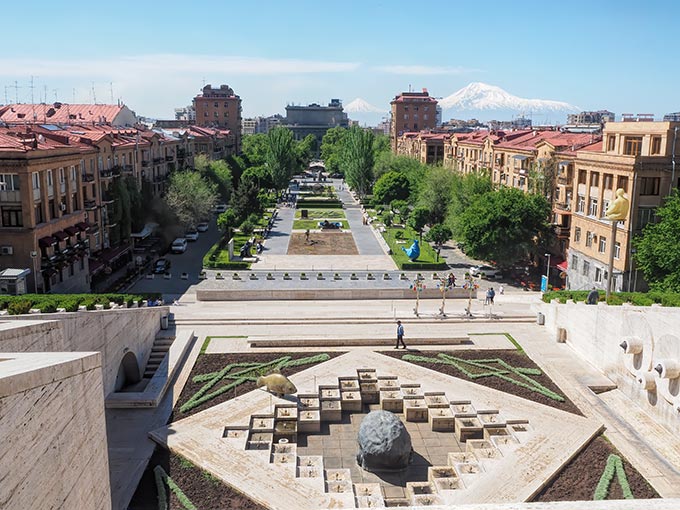
At the top I sat down to rest and contemplate the obelisk sculpture that rises from the top of the hill. Crafted in Brutalist style, it celebrates the 50th anniversary of the Soviet occupation of Armenia. Though Armenia officially declared its independence from the Soviet Union on September 21, 1991, the monument still stands, perhaps a nod to the continued good relationship between Russia and Armenia today.

By the time I walked back down those 572 steps my knees were killing me, so I headed back to Republic Square and recovered over a long, delicious lunch at the Coffeeshop Company. As with every other Armenian person I had net during the day, my server was curious about me. Where was I from? Why was I in Armenia? Tourism is not an important part of the country’s economy, and to say that tourists are rare in Armenia is not an exaggeration. Considering that most Americans couldn’t pick out their country on a map of Europe, to a person they were astounded by the idea that an American woman traveling alone would be visiting Armenia.
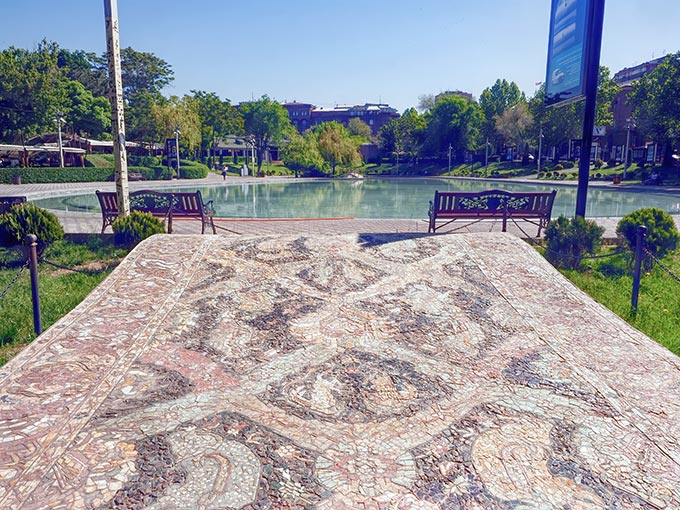
My server was so amazed that he literally sat down at my table and talked to me for more than 20 minutes. “You must visit the countryside,” he insisted. “Ours is a small country, but it is lush and green and filled with welcoming people.” I took his advice. Back at my hotel that evening, I booked tours to the most important historic sites for the following two days. My English-speaking guide, Artur, met me at 10 a.m. the next morning and we set off through a landscape where fields of wildflowers stretched toward snow-capped mountains.
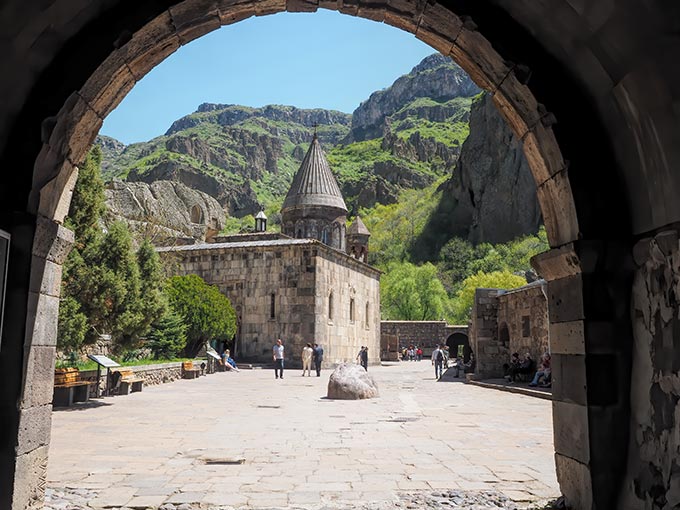
Our first stop was Ararat (Charents) Arch, named jointly for a famous Armenian poet (Charents), who used to come to this spot for inspiration, and because it has a great view of Mount Ararat. We continued to Geghard Cave Monastery, carved from solid rock into the side of a mountain. In addition to a sacred spring that burbles up inside the cave, the site is renowned for its collection of carved steles that serve as memorial stones. Known as Khachkars, they portray a decorative cross resting on a symbol of a sun or wheel of eternity. These stele, which can reach more than five feet in height, are believed to have the power to save a soul. Pilgrims from all over the world come to kneel before these spectacular Armenian cross-stones.


Next up was the Fortress of Garni, also known at the Garni Temple. In 1968, a copy of an early pagan temple was constructed on the spot where the original temple had stood. However, some of the other ruins are original, including the remains of a Catholic Church that was built adjacent to the temple and later converted to a palace. More interesting were the ancient artifacts scattered around the site.


There was such a feeling of peaceful energy at Garni Temple that I wanted to stay longer. But I couldn’t dally. Artur was waiting for me at a local guest house just down the road, where he had arranged for the owners to prepare a vegetarian lunch for me. It was way too much food: three kinds of goat cheese; Greek salad; two kinds of roast potatoes; fresh spices (green onions, tarragon, parsley, and basil, meant to be wrapped in the fresh lavash); bread; Tabbouleh; coffee; and an incredible homemade plum juice. It was scrumptious.
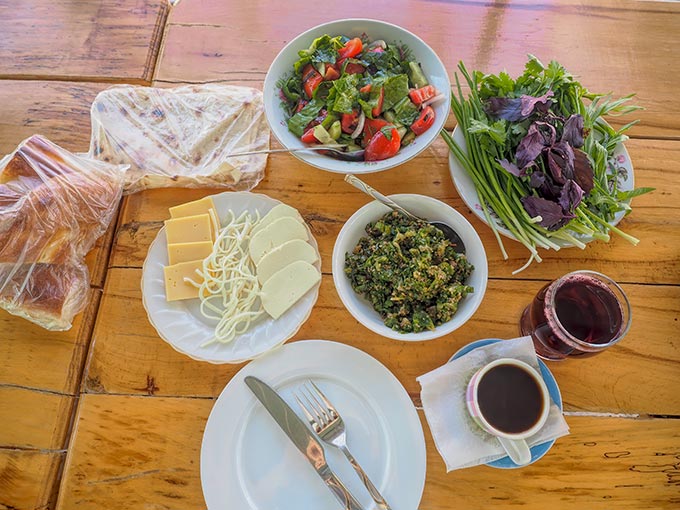
On day two, Artur and I headed for Khor Virap Sanctuary. On this site, St. Gregory the Illuminator was imprisoned in a six-meter deep pit for 13 years until he was called upon to cure the King’s madness. He accomplished this miracle and succeeded in converting the King to Christianity, making Armenia the first country in the world accept Christianity as their State religion. As with every other place I’d seen this tiny country, Khor Virap is made more magnificent by Mount Ararat and Little Mount Ararat rising majestically behind it. Ironically, though it is located just eight miles from Khor Virap, the devoutly Christian Armenians are prohibited from visiting the mountain where Noah’s Ark is believed to have come aground because it is located in Turkey, an enemy of Armenia.
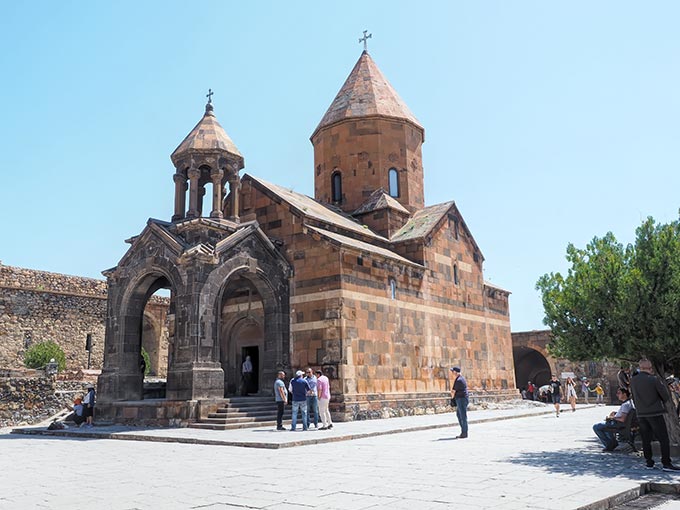
I would come to understand that, with the exception of Georgia to the north, tiny Armenia is surrounded by enemies. Armenia and Azerbaijan are among the many countries that declared independence following the breakup of the Soviet Union. As countries struggled to define their national territory, boundary disputes inevitably arose. The ownership of one such area, Nagorno-Karabakh, was hotly contested by Armenia and Azerbaijan. Located to the southeast of present day Armenia, it is an area that the international community considers a part of Muslim Azerbaijan, but is predominantly inhabited by Christian Armenians. Over the ensuing years, tensions and armed skirmishes have often flared up between the two countries. Neighboring countries took sides: Turkey supports Azerbaijan while Russia supports Armenia.
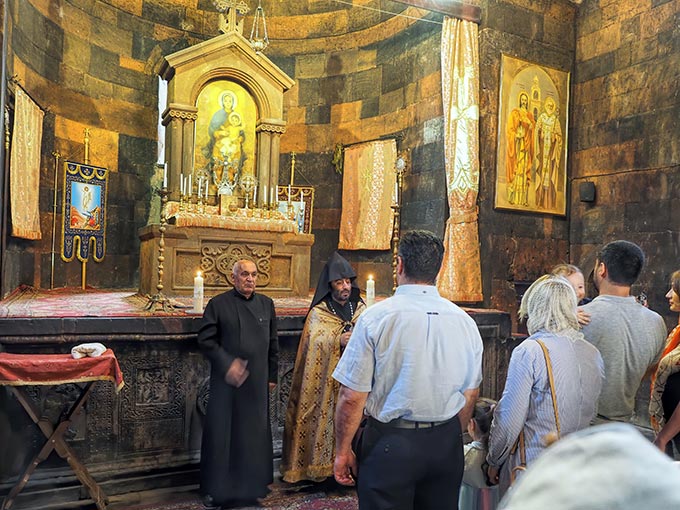
Until recently, the only access to visit Nagorno-Karabakh was through Armenia. Azerbaijani authorities consider such a crossing to be illegal entry into Azerbaijani territory. Thus, if a passport shows any evidence of visiting the Republic of Nagorno Karabakh, Azerbaijani consulates will not grant a visa. Travelers who receive an electronic visa for Azerbaijan will be turned away at the border. There have even been documented cases of people being allowed in and then deported or even arrested when they attempt to enter Azerbaijan with a Karabakh visa and entry stamp in their passport.
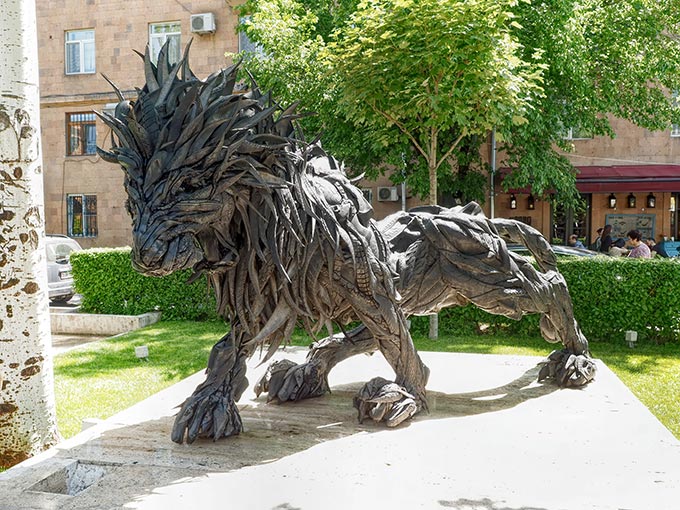
Timing came into play once again when I began writing about the Caucasus countries. I published my first article about Baku, Azerbaijan, on September 26th. The following morning I woke to the news that a tenuous 1994 cease fire between Armenia and Azerbaijan had failed. Armed conflict had once again broken out over the contested region. I didn’t know whether to continue with my planned series of stories or to delay until some semblance of peace was restored. I waited for three weeks, but it seemed clear that this conflict was not going to conclude anytime soon. In the end, I decided to resume writing, primarily because it was still safe to visit both Armenia proper and Azerbaijan. Most tourists are unlikely to have any interest in visiting Nagorno-Karabakh, even when there is not an active war.
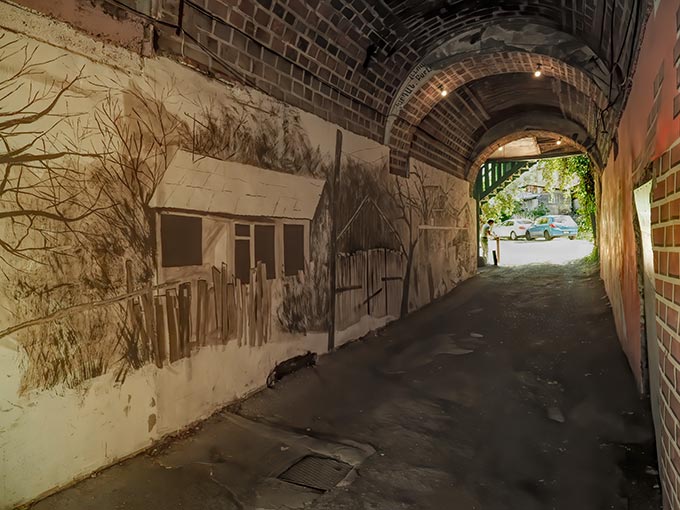
Russia and Turkey both intervened, with Russia taking on the role of mediator. Russia has long been allied with Armenia, though it has also maintained good relations with Azerbaijan. Turkey sided with Azerbaijan; back in July they began taking part in large-scale joint exercises in Azerbaijan. In recent days, Russia has brokered a cease fire that seems to be holding…for the moment. The terms call for Azerbaijan to retain control of the land they regained during the recent hostilities. Armenia has agreed to a staged withdrawal of forces in the remaining areas of Nagorno-Karabakh, while Russian forces will be deployed as a peacekeeping contingent for at least the next five years. Withdrawal of Armenian troops has already begun and is scheduled to be completed by December 1st, however it is anything but certain that the cease fire will continue to be honored. While Azeris are jubilantly parading their flag through the streets of Baku, Armenians are reportedly furious over the news that their Prime Minister has signed the agreement ceding Armenian land to Azerbaijan.
For me, this news is more sad than anything. I abhor war and violence, and the fact that I loved my time in Azerbaijan as much as I loved visiting Armenia makes the current situation all the more sad. For the moment, the question of whether or not to visit either country is a moot point, as COVID-19 restrictions precludes tourism. My hope is that peace will prevail by the time the COVID vaccine has been widely distributed, making it safe to visit both countries, but especially Armenia, may favorite of the Caucasus countries.
You may also enjoy:
Potemkin Stairs in Odessa, Ukraine
Baku, Azerbaijan, The Smell of Money
Tbilisi, Georgia – I Was Unimpressed

Thank you. What an incredibly helpful and informative post
You’re welcome Becky. Glad you found it helpful.
Such a Amazing Post as always. The photos were fabulous. Really it was a wonderful experience!
Amazing Post as always. This is exactly what I looking for to start planning my next Armenia trip at the end of this year if everything will be ok.
Thank you for sharing and I look forward to more in the future.
Thanks so much Flora. I’m sure you’ll enjoy Armenia. I especially loved the capital city, Yeravan.
Another truly amazing experience which you invited us to read. I felt like I was visiting with you. The photos were fabulous.
Thank you Barbara. I continue to read your articles and enjoy each one.
Thanks so much Irene! I always love it when fans tell me my stories make them feel like they were right there with me 🙂
Thank you so much for this information. This is exactly the information i was looking for. Cant wait till i travel to Armenia once this pandemic is over. Just a quick question, how about the food in Armenia since i’m a vegetarian i want to know?
Although much of the cuisine is meat-centric, I had absolutely no problem finding vegetarian items at cafes around town and even in the countryside.
Armenia was added to my travel ‘wish list’ only a few years ago based on the recommendations of a few friends who had recently visited. I’m so glad to hear you too found its capitol, Yerevan, to be delightful — your wonderful photos make it look very appealing. Hearing that your waiter was so eager to speak with you, an American solo traveler, was very heartwarming. I love it when your expectations of visiting a new destination turn out even better than you had hoped for!!
Hi Sylvia: So pleased you found my article about Armenia to be interesting. I really liked the country and the people. I went with little knowledge or up-front research because, as always, I want to arrive with no expectations. In the case of Armenia, I was pleasantly surprised. Hope you get to visit one day. Oh, and I forgot to mention in the story that it’s extremely affordable to go there.
Thank you for a lovely report. I could see myself making the same trip. I’m fascinated by the color of the stone. I look forward to seeing it. My family also plans to make this trip in the near future and we would welcome your contact information on the local guide etc.
Hi Dona: So pleased you liked my story. I just loved Armenia and I’m sure you will too. Unfortunately, I don’t have any contact information for my guide. He was booked by my hotel upon arrival. I stayed a the Republic Square Boutique Hotel. I can highly recommend the hotel. The facilities are very nice and the staff is super helpful. I’m sure they could arrange an English-speaking guide for you as well.
Thank you for this informative and fascinating article Barbara. You bring each place you write about to life. I love that you included the Botero sculpture. After visiting Medellin last year, Botero’s work holds a special place in my heart. I was especially touched by his two Birds of Peace in San Antonio Plaza.
Hi Linda: Thanks so much for saying that my stories bring places to life. That’s just about the highest compliment yo can give a writer. Also, there’s more than one Botero sculpture in Yerevan. Must mean you;re destined to go there!
A very interesting read, Barbara, especially the update about the Nagorno-Karabakh situation and the difficulties that creates for travellers. Very useful information! But I hope you don’t mind me pointing out one error: Armenia and Georgia are in Western Asia, not Eastern Europe. It’s a mistake that many from other parts of the world make, but Europe ends at the Bosphorus – that’s why in Istanbul they talk abut the European side of the city and the Asian side. If any of your readers doubt that, they can refer to the United Nations listings of countries in Europe and Asia.
Hi David: Ah! I think we are going to have to agree to disagree on this one. I did a fair amount of research about whether or not the Caucasus region was considered to be in Europe or Asia. Most everyone agrees that Georgia and Azerbaijan are in Europe, but experts are split over Armenia. You are correct that the United Nations lists it as being in Asia, however many other authoritative sources declare it is part of Europe. The BBC declares it as an Eastern European country. Thomas de Waal, Senior Fellow at Carnegie Europe and author of The Caucasus: An Introduction, says the conventional practice is to call it Europe. But he admits that the question is unsettled. Geographically, Armenia is south of the Greater Caucasus mountain range, which is generally accepted as the border between Asia and Europe. Thus the geographic test would put it in Asia. But culturally, Armenia has been influenced by both the east and west. Historically the country had close ties with the Romans and Greeks. The food is certainly comparable to Greek cuisine. The Armenian language is Indo-European, and the primary religion is Christianity. Not to mention that the capital city of Yerevan is as European as any capital in Western Europe. I think the best solution is to refer to the Caucasus as Eurasian countries, and I personally list them in both categories. Thanks so much for your comment. It’s a thought-provoking subject.
Thank you for this beautiful report on Armenia. Have postponed our trip for two years due to conflict in the area (2019 Iran & USA). Maybe 2021 the virus will be gone and we will finally get there. Would you share the contact information on your local guide? We were planning two/ three weeks in Armenia with Yerevan as our home base and Hiring local guide with car for day/days trips. Have wanted to visit since I saw a Joseph Rosendo Travelscopes episode on PBS TV program. Stay safe and healthy!
Merry Christmas, too!
Hi Mark: I’m afraid I don’t have any contact information for my guide. I tried to find one prior to arriving, but was not able to find an English speaking guide. Fortunately, my hotel was able to arrange it for me upon arrival. I stayed a the Republic Square Boutique Hotel. I can highly recommend them. The place was recently refurbished, they had a great breakfast, the rooms were spacious and clean, and they helped me with everything from where to find vegetarian food to the location of ATM’s. Hope you are staying safe and healthy as well, and a Merry Christmas to you too!